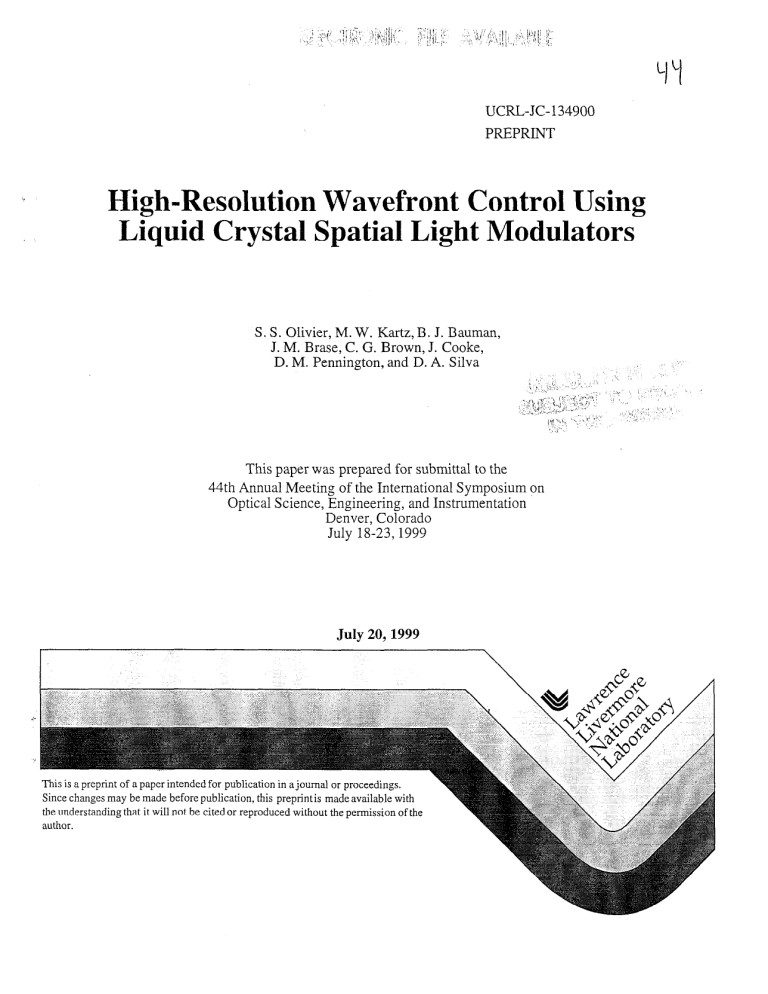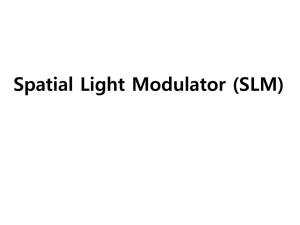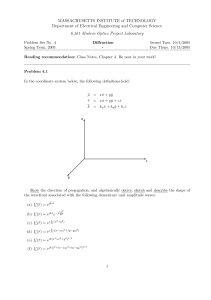PDF - UNT Digital Library

UCRL-JC- 134900
PREPRINT
High-Resolution Wavefront Control Using
Liquid Crystal Spatial Light Modulators
S. S. Olivier, M. W. Kartz, B. J. Bauman,
J. M. Brase, C. G. Brown, J. Cooke,
D. M. Pennington, and D. A. Silva
,.<,
-.
This paper was prepared for submittal to the
44th Annual Meeting of the International Symposium on
Optical Science, Engineering, and Instrumentation
Denver, Colorado
July l&23,1999
July 20,1999
This is a preprint of a paper intended for publication in a journal or proceedings.
Since changes may be made before publication, this preprintis made available with the understanding that it will not be cited or reproduced without the permission of the author.
DISCLAIMER
This document was prepared as an account of work sponsored by an agency of the United States Government. Neither the United States Government nor the
University of California nor any of their employees, makes any warranty, express or implied, or assumes any legal liability or responsibility for the accuracy, completeness, or usefulness of any information, apparatus, product, or process disclosed, or represents that its use would not infringe privately owned rights.
Reference herein to any specific commercial product, process, or service by trade name, trademark, manufacturer, or otherwise, does not necessarily constitute or imply its endorsement, recommendation, or favoring by the United States
Government or the University of California. The views and opinions of authors expressed herein do not necessarily state or reflect those of the United States
Government or the University of California, and shall not be used for advertising or product endorsement purposes.
High-resolution wavefront control using liquid crystal spatial light modulators
Scot S. Olivier*, Michael W. Kartz, Brian J. Bauman,
James M. Brase, Curtis G. Brown, Jeffrey B. Cooke,
Deanna M. Pennington, Dennis A. Silva
Lawrence Livermore National Laboratory, PO Box 808, Livermore, CA 9455 1
ABSTRACT
Liquid crystal spatial light modulator technology appropriate for high-resolution wavefront control has recently become commercially available. Some of these devices have several hundred thousand controllable degrees of freedom, more than two orders of magnitude greater than the largest conventional deformable mirror. We will present results of experiments to characterize the optical properties of these devices and to utilize them to correct aberrations in an optical system. We will also present application scenarios for these devices in high-power laser systems.
Keywords: adaptive optics, lasers, spatial light modulators, liquid crystals
1. INTRODUCTION
Precise wavefront control is critical for many high-power laser applications including inertial confinement fusion, laser isotope separation, and laser machining. There are many ways that laser wavefront quality can be degraded. Thermal effects due to the interaction of high-power laser or pump light with the internal optical components or with the ambient gas are common causes of wavefront degradation. For many years, adaptive optics based on thin deformable glass mirrors with piezoelectric or electrostrictive actuators have been used to remove the low-order wavefront errors from high-power laser systems. These adaptive optics systems have successfully improved laser beam quality, but have also often revealed additional high-spatial-frequency errors, both because the low-order errors have been reduced and because deformable mirrors have often introduced some high-spatial-frequency aberrations due to manufacturing errors. Many current laser applications could benefit from correction of high spatial frequency aberrations that can only be provided with correctors with thousands of degrees of freedom. This level of correction is beyond the state of the art of deformable mirror technology.
The largest deformable mirrors currently available have -1000 degrees of freedom at a cost of -$lM. Even if the deformable mirror technology could be extended to more actuators, the cost would likely be prohibitive. Therefore, a new approach using a different wavefront control technology may be required. One new wavefront control approach is the use of liquid crystal (LC) spatial light modulator (SLM) technology for the control of the phase of linearly polarized light. Current LC
SLM technology provides high-spatial-resolution wavefront control, with hundreds of thousands of degrees of freedom, more than two orders of magnitude greater than the largest deformable mirrors. Furthermore, even with the increased spatial resolution, the cost of these devices is nearly two orders of magnitude less than the cost of the largest deformable mirror.
2. SLM TECHNOLOGY
The LC SLM devices utilized in the investigations described in this paper are a variety of optically addressed (OA) nematic
LC SLM currently available from both Jenoptik and Hammamatsu. These devices are capable of phase correction of greater than one wave at visible and near-ink-a-red wavelengths. An OA LC SLM consists of a thin-film sandwich structure, shown in Figure 1, with an amorphous silicon (c&i) photo-semiconductor, a parallel aligned nematic liquid crystal, a dielectric mirror, and a pair of transparent electrodes on glass substrates. The voltage applied to the electrodes is divided between
* Correspondence: email: olivierl @ llnl.gov; phone: 925-423-6483; fax: 925-422-1796
photo-semiconductor and liquid crystal layers, depending on the illumination intensity, thereby enabling modulation of the refractive index of the LC by a 2D image.
Figure 1. Schematic of optically addressed liquid crystal spatial light modulator
To activate the OA LC SLM the cx-Si layer must be exposed to an image pattern. The resolution of the SLM is directly proportional to the resolution of the image pattern projected onto the a-Si layer up to some limit. In the state where no image is incident on the device, the impedance of the cc-Si layer is very high, with or without the voltage applied across the electrodes. When an image pattern is projected onto the a-Si layer, the impedance of the ol-Si is reduced in proportion to the light intensity in that region, and the voltage applied to the liquid crystal is increased. This increased voltage causes an increase in the index of refraction in the liquid crystal layer due to reorientation of the liquid crystal molecules.
The resolution of the image projection system (which in this case is based on a liquid crystal display or LCD) determines at the resolution at which the SLM will effect the read beam. The currently available devices have the capability of providing control of up to 50 line-pairs/mm. The device from Jenoptik comes with a 832 x 624 LCD and Hamamatsu provides a 640 x
480 LCD. The operational configuration is shown in Figure 2.
These devices work with polarized light. The maximum phase shift is obtained when the polarization of readout light is parallel to the axis of the liquid crystal molecules. When the polarization of readout light is perpendicular to the axis of the liquid crystal molecules, the phase shift is negligible.
Figure 2. crystal spatial light modulator
3. PHASE RECONSTRUCTION METHODS
Accurately controlling wavefront phase with a high-spatial-resolution wavefront correction device requires a high-spatial. resolution wavefront measurement capability. This can be provided with a standard Shack-Hartmann wavefront sensor using available high-density lenslet arrays. However, computational requirements for traditional matrix-vector multiply wavefront reconst~ction algorithms using slope data from a Shack-Hartmann (or other wavefront slope) sensor scale as N2 where N is the number ofphase points. For large N, greater than -10’ this begins to become impractical. Since the slope measurement of the Sback-Hanmann sensor can be rePr;syted by a spatial filtering operation, an inverse filter can be designed to directly recover the wavefront from the Slope data. This allows the reconstruction process to be implemented as a 2~ convo]ution operation using ms, which scale as NlogzN. We have used computer simulations to demonstrate that for 4096 phase
Points the m-bawd algorithm is -30 times faster than a matrix multiply (Figure 3). A similar approach has been utilized by
Chanteloup et al with a shearing interferometer as the wavefront slope sensor.?
Figure 3. Computational scaling for phase reconstruction algorithms
We have used he m-based reconstruction method in lab experiments using the test-bed described in Figure 5 with a Shack-
Hartnxm sensor with >2500 subapertures and using a IKxlK-pixel camera. To verify that the algorithm would accurately represent the pattern generated, a Checkered Phase pattern WZG Produced on the LC SLM and Shack-Hartmann image data was recorded (Figure 4a). The wavefront phase was then reconstructed using the FFTbased method (~@,r~ 4bj. ~~ resulting Phase reCOnStrUCtIon acCurate]y depicted the applied checkered phase pattern. Additional tests were Performed using different phase patterns with each reconstruction accurately representing the applied pattern.
4. SLM EXPERIMENTAL TEST BED
A test-bed, shown schematically in Figure 5,
has been assembled to allow the evaluation of SLM devices for high.spati& resolution SPatia] wavefront Control. This test-bed provides the capability to place both low-order and high-order aberrations
onto a beam, to detect these aberrations with a high-spatial-resolution Shack-Hanmann sensor. and to correct these phase aberrations using the OA LC SLM. This process is currently implemented using multiple computer systems in a human-in- the-loop closed-loop operation.
“.b”tma
.
.
Figure 5. High-resolution wavefront control test-bed schematic
5. EXPERIMENTAL RESULTS
An initial set of experiments has been completed using the Jenoptik OA LC SLM. In these experiments, an aberration was placed into the main beam path (Figure 6a) and the resulting high-resolution Shack-Hartmann image was processed using the m-based method to reconstruct the phase (Figure 6b). From the reconstructed phase an appropriate correction image was generated and applied via the SLM. The applied correction produced a significantly improved far field spot (Figure 6~). The corrected wavefront was reanalyzed with the same methods and a significant improvement was observed in the reconstructed phase image (Figure 6d).
I
Figure 6. Initial High-resolution closed-loop wavefront control experimental resulu.
Similar experiments utilizing the Hamamatsu AO-LC SLM are currently underway in the SLM test-bed with some modifications to improve the collimation of the write-beam from the back-light diode and thereby improve the correlation between the image pattern generated on the LCD and the phase correction produced by the SLM.
6. FUTURE PLANS
Design for the introduction of an OA LC SLM into a high-powered short-pulse laser is also currently in progress. The OA LC
SLM will be used to correct high-spatial-frequency phase errors in the front end of the Petawatt Short-Pulsed Laser. 4s In this experiment, we will be testing the ability of the SLM to correct for high-spatial-frequency errors and the effects on transport of the correction through the spatial filters of the system. The OA LC SLM will also be inserted into the system in two additional locations that have a higher beam fluence to evaluate the performance in high-power conditions and to determine the damage threshold.
ACKNOWLEDGEMENTS
The authors would like to acknowledge the technical assistance of J. An, C. Carrano, R. Hurd, and R. Sawvel. Work performed under the auspices of the U.S. Department of Energy by the Lawrence Livermore National Laboratory under
Contract number W 7405-Eng-48.
REFERENCES
1.
2.
3.
4.
5.
K. Freischland and C. L. Koliopoulos, “Wavefront Reconstruction from Noisy Slope or Difference Data Using the
Discrete Fourier Transform”, Proc. SPZE 551, 1985.
D. C. Ghiglia and L. A. Romero, “Robust two-dimensional weighted and unweighted phase unwrapping that uses fast transforms and iterative methods”, J. Opt. Sot. Am, A 11, pp. 107-117, 1994.
J. C. Chanteloup, F. Druon, M. Nantel, A. Maksimchuk, G. Mourou, “Single-shot wave-front measurements of high- intensity ultrashort laser pulses with a three-wave interferometer”, Opt. Letr., 23, pp. 621-623, 1998.
M. D. Perry, D. Pennington, B. C. Stuart, G. Tietbohl, J. A. Britten, C. Brown, S. Herman, B. Golick, M. Kartz, J. Miller,
H. T. Powell, M. Vergino, and V. Yanovsky, “Petawatt laser pulses”, Opt. La., 24, pp. 160-162, 1999.
D. M. Pennington, C. G. Brown, M. Kartz, M. Landon, M. D. Perry, G. Tietbohl, “Production of high intesity laser pulses with adaptive optics”, International Workshop on Adaptive Optics for Industry and Medicine, Durham, England,
July 12-16, in press, 1999.






